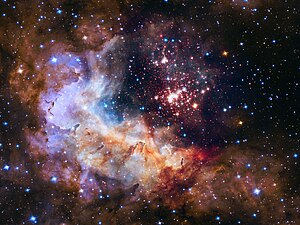Westerlund 2
| Westerlund 2 | |
|---|---|
 The cluster Westerlund 2 and its surroundings Credit: Hubble Space Telescope | |
| Observation data (J2000 epoch) | |
| Constellation | Carina |
| Right ascension | 10h 23m 58.1s[1] |
| Declination | −57° 45′ 49″[1] |
| Distance | 20000 ly (6000 pc) |
| Apparent magnitude (V) | 10.5[1] |
| Physical characteristics | |
| Notable features | Contains some of the hottest, brightest, and most massive stars. |
| Other designations | ESO 127-18, VDBH 95[1] |
Westerlund 2 is an obscured compact young star cluster (perhaps even a super star cluster[2]) in the Milky Way, with an estimated age of about one or two million years. It contains some of the hottest, brightest, and most massive stars known. The cluster resides inside a stellar breeding ground known as Gum 29, located 20,000 light-years away in the constellation Carina. It is half a degree from the naked eye Cepheid variable V399 Carinae.[3]
Cluster members[]
The cluster contains at least a dozen early O stars, of which at least three are eclipsing binaries. All are hotter than 38,000 K and more luminous than 230,000 L☉.[4] There are around 20 further O class stars in the cluster, all main sequence objects implying a very young age for the cluster.[5]
Several Wolf–Rayet stars are found in the vicinity of Westerlund 2, although not in the central core. WR 20a, a binary consisting of two WR stars, and the single stars , , and are all thought to be members of the cluster, although possibly now runaway members. All five Wolf Rayets are extremely young massive objects with OIf*/WN spectral types, amongst the most luminous stars in the galaxy. This composite spectral type indicates young very massive hydrogen-burning stars that are just starting to convect nitrogen and helium to the surface and develop denser stellar winds so that they show the emission lines of a Wolf-Rayet star. WR21a, itself a massive binary, lies in the same direction but is unlikely to be a member of Westerlund 2.[6]
Westerlund 2 also contains a large number of pre-main sequence stars with masses below 2.5 M☉. These stars constrain the age of the cluster to near 2 Myr.[7]
Discovery[]

As its name indicates, the Westerlund 2 cluster was discovered by Bengt Westerlund in the 1960s[8] but its stellar content was assessed only in later years.[9]
Hubble 25th Anniversary Image[]
On 23 April 2015 an image of the Westerlund 2 cluster was chosen to celebrate the 25th anniversary of the Hubble Space Telescope.[3]
See also[]
References[]
- ^ a b c d "Cl Westerlund 2". SIMBAD. Centre de données astronomiques de Strasbourg. Retrieved 1 May 2018.
- ^ Y. Fukui; et al. (2015). "Cloud-cloud collision which triggered formation of the super star cluster RCW38". The Astrophysical Journal. 1504: 26. arXiv:1504.05391. Bibcode:2016ApJ...820...26F. doi:10.3847/0004-637X/820/1/26.
- ^ a b "Hubble Space Telescope Celebrates 25 Years of Unveiling the Universe". NASA. 23 April 2015.
- ^ Rauw; et al. (1 March 2007). "Early-type stars in the core of the young open cluster Westerlund 2". Astronomy & Astrophysics. 463 (3): 981–991. arXiv:astro-ph/0612622. Bibcode:2007A&A...463..981R. doi:10.1051/0004-6361:20066495.
- ^ Hur, Hyeonoh; Park, Byeong-Gon; Sung, Hwankyung; Bessell, Michael S.; Lim, Beomdu; Chun, Moo-Young; Sohn, Sangmo Tony (2015). "Reddening, distance, and stellar content of the young open cluster Westerlund 2". Monthly Notices of the Royal Astronomical Society. 446 (4): 3797–3819. arXiv:1411.0879. Bibcode:2015MNRAS.446.3797H. doi:10.1093/mnras/stu2329.
- ^ Carraro, G.; Turner, D.; Majaess, D.; Baume, G. (2013). "The distance to the young open cluster Westerlund 2". Astronomy. 555: A50. arXiv:1305.4309. Bibcode:2013A&A...555A..50C. doi:10.1051/0004-6361/201321421.
- ^ Ascenso, J.; Alves, J.; Beletsky, Y.; Lago, M. T. V. T. (2007). "Near-IR imaging of Galactic massive clusters: Westerlund 2". Astronomy and Astrophysics. 466 (1): 137–149. Bibcode:2007A&A...466..137A. doi:10.1051/0004-6361:20066433.
- ^ Bengt Westerlund (1 March 1961). "A Heavily Reddened Cluster in Ara". Astronomical Journal. 70: 57. Bibcode:1961AJ.....66T..57W. doi:10.1086/108585.
- ^ Moffat; et al. (1 August 1991). "New Wolf-Rayet stars in Galactic open clusters - Sher 1 and the giant H II region core Westerlund 2". Astronomical Journal. 102: 642–653. Bibcode:1991AJ....102..642M. doi:10.1086/115897.
External links[]
| Wikimedia Commons has media related to Westerlund 2. |
- Open clusters
- Carina (constellation)
- Star-forming regions